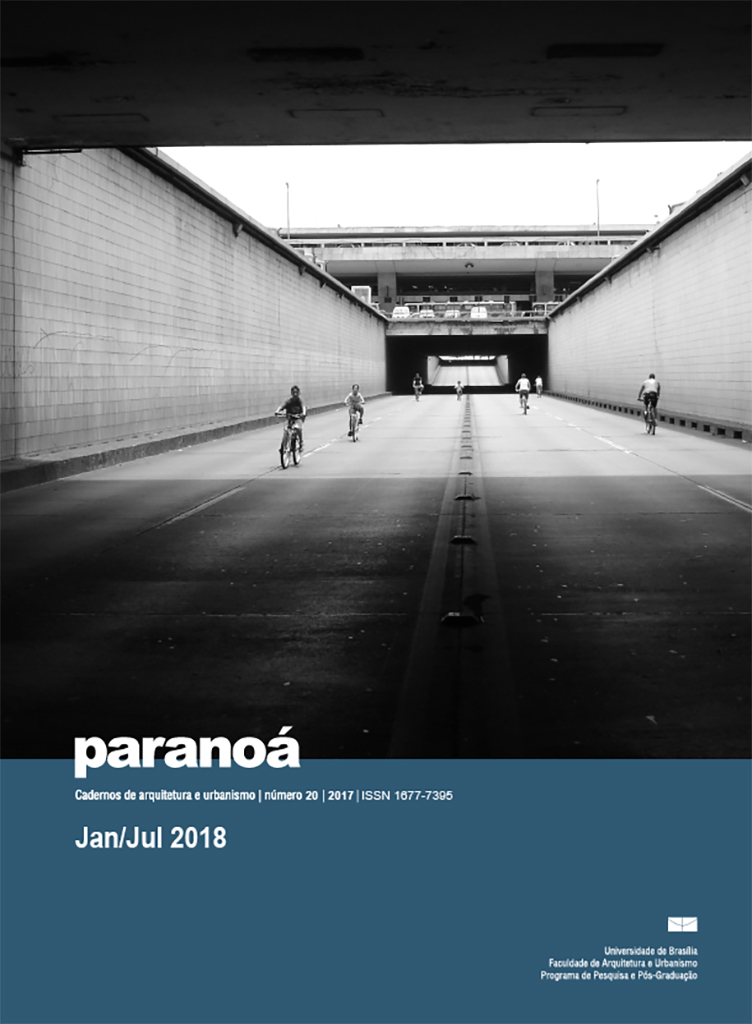Geração de Mapas de Danos de Formação de Manchas em Fachadas a Partir dos Métodos de DSM e PDI, e Utilização de VANT
DOI:
https://doi.org/10.18830/issn.1679-0944.n20.2018.05Keywords:
Maps of damages, Digital Photogrammetry, Points of cloud, Digital image processingAbstract
The aim of this study was to apply a methodology for automatic generation of maps of damages in orthoimages of façades, using UAVs to capture the photographs. The generation of maps of damages aims to assist in the visual inspection method used in activities of maintenance, restoration or intervention in buildings. Using the dense stereo matching (DSM) method, geometric models of buildings have been generated by the point cloud in the PhotoScan program for obtaining orthoimages. After this step, the orthoimages were submitted to generation of maps of damages of staining in Tyche program, which mapped and quantified in percentage terms these defects. The results of the maps of damage were also classified qualitatively. The application of UAV proved to be an efficient tool for façade inspection activity and for capturing images to be used by DSM. The generation of maps of damages by Tyche proved also effective, however was established that the user interaction was important to achieve the expected results.
References
AMORIM, A. L. Fotogrametria: uma introdução. In: PRATINI, E. F., SILVA, E. A. Criação, representação e visualização digitais. Brasília, DF: Faculdade de Tecnologia da Universidade de Brasília, 2012. p. 63-89.
BRITO, Bruno Leão de; GROETELAARS, Natalie Johanna, AMORIM, Arivaldo Leão de. O uso da tecnologia dense stereo matching para levantamento de edificações existentes. In: SEMINÁRIO NACIONAL DE DOCUMENTAÇÃO DO PATRIMÔNIO ARQUITETÔNICO COM O USO DE TECNOLOGIAS DIGITAIS, II .2012, Belém. Anais... Belém: ARQDOC, 2012.
DONEUS, M.; VERHOEVEN, G.; FERA; M.; BRIESE, CH.; KUCERA, M.; NEUBAUER, W. From deposit to point cloud ”“ a study of low-cost computer vision approaches for the straightforward documentation of archaeological excavations. In: INTERNATIONAL CIPA SYMPOSIUM, 23rd. Procedings…. Prague, Czech Republic, September 12”“16, 2011.
ESQUEF, I. A.; ALBUQUERQUE, M. P.; ALBUQUERQUE, M. P. Processamento digital de Imagens. Rio de Janeiro, 2003. p. 12. Centro Brasileiro de Pesquisas Físicas.
GONZALEZ, R. C.; WOODS, R. E. Digital image processing. 3d. Reading, MA: Addison-Wesley, 2010. 716 p.
GROETELAARS, N. J.; AMORIM, A. L. Dense Stereo Matching (DSM): conceitos, processos e ferramentas para criação de nuvens de pontos por fotografias. In: SIGRADI 2012 - CONGRESO DE LA SOCIEDAD IBEROAMERICANA DE GRÁFICA DIGITAL, 2012, Fortaleza. SIGraDi 2012 [Proceedings of the 16th Iberoamerican Congress of Digital Graphics], 2012. p. 361-365.
GROETELAARS, N. J. Um estudo da fotogrametria digital na documentação de formas arquitetônicas e urbanas. 2004 Dissertação (Mestrado em Arquitetura e Urbanismo). Universidade Federal da Bahia, Faculdade de Arquitetura. Salvador, 2004.
KOUTSOUDIS, A. VIDMAR, B., IOANNAKIS, G., ARNAOUTOGLOU, F., PAVLIDIS, G, CHAMZAS, C. Multi-image 3D reconstruction data evaluation. Journal of Cultural Heritage [online] http://dx.doi.org/10.1016/j.culher.2012.12.003. Acesso em: 5 fev 2014.
KOUTSOUDIS, Anestis; Vidmar; Blaz; ARNAOUTOGLOU, Fotis; REMONDINO, Fabio; BASSETT, Sheena; CHAMZAS, Christos. 3D ICONS ”“ 3D Digitisation of icons of european architectural and archaeological heritage. Case studies for testing the digitisation process interim report. 2012. Project co-funded by the European Commission within the ICT Policy Support Programme. 2012
LI, J.I.E.; SHI, Wenxuan; DENG, Dexiang; JIA, WENYAN; SUN, Mingui. Dense stereo matching method based on local affine model. Journal of Computers, vol. 8, no. 7, July 2013.
PEDRINI, Hélio; SCHWARTZ, William Robson. Análise de imagens digitais: Princípios, algoritmos e aplicações. 30. ed. São Paulo: Thomson Learning, 2008.
PIERROT-DESEILLIGNY, Marc; DE LUCA, Livio; REMONDINO, Fabio. Automated image-based procedures for accurate artifacts 3D modeling and orthoimage generation. Geoinformatics CTU FCE. 2011. Disponível em: <http://cipa.icomos.org/ fileadmin/ template/ doc/PRAGUE/113.pdf>. Acesso em: 14 jun 2012.
REICH, M.; WIGGENHAGEN, M.; MUHLE, D. Filling the holes - Potential of UAV-based photogrammetric facade modelling. Tagungsband des 15. 3D-NordOst Workshops der GFaI, ISBN 978-3-942709-07-1, S. 147-156, 2012.
RUIZ, Luis Angel; LERMA, José Luiz; GIMENO, Josep. Application of computer vision techniques to support in the restoration of historical buildings. In: INTERNATIONAL SOCIETY FOR PHOTOGRAMMETRY AND REMOTE SENSING, 2002, Graz-Austria. Anais... Graz-Austria: ISPRSP, 2002. P. 227-230.
SOLOMON, C.; BRECKON, T. Fundamentos de processamento digital de imagens ”“ uma abordagem prática com exemplos em Matlab. Rio de Janeiro: LTC, 2013.
SZELISKI, R. Computer vision: Algorithms and applications. London: Springer, 2010.
TANG, L.; WU, C., CHEN, Z. Image dense matching based on region growth with adaptive window. ISN National Key Lab, Institute of Comm. Eng., Xidian University, Xi’an 710071, China Received 8 July 2002; received in revised form 20 October 2002.
VERHOEVEN, G. Taking computer vision aloft ”“ archaeological three-dimensional reconstructions from aerial photographs with photoscan. Archaeological Prospection. V 18, nº 1; 2011, 67-73.
WALFORD, Alan. A new way to 3D scan: photo-based scanning saves time and money. 2009. Disponível em: <http://www.photomodeler.com/downloads/ScanningWhitePaper.pdf>. Acesso em 14 mai. 2013.
Published
Issue
Section
License
Autores que publicam nesta revista concordam com os seguintes termos:
- Autores mantém os direitos autorais e concedem à revista o direito de primeira publicação, com o trabalho simultaneamente licenciado sob a Licença Creative Commons Attribution que permite o compartilhamento do trabalho com reconhecimento da autoria e publicação inicial nesta revista. http://creativecommons.org/licenses/by/4.0
- Autores têm autorização para assumir contratos adicionais separadamente, para distribuição não-exclusiva da versão do trabalho publicada nesta revista (ex.: publicar em repositório institucional ou como capítulo de livro), com reconhecimento de autoria e publicação inicial nesta revista.
- Autores têm permissão e são estimulados a publicar e distribuir seu trabalho online (ex.: em repositórios institucionais ou na sua página pessoal) a qualquer ponto antes ou durante o processo editorial, já que isso pode gerar alterações produtivas, bem como aumentar o impacto e a citação do trabalho publicado (Veja O Efeito do Acesso Livre).


















